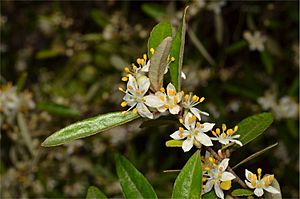Asterolasia correifolia facts for kids
Quick facts for kids Asterolasia correifolia |
|
|---|---|
 |
|
| In Australian National Botanic Gardens | |
| Scientific classification | |
| Genus: |
Asterolasia
|
| Species: |
correifolia
|
| Synonyms | |
|
|
Asterolasia correifolia is a type of shrub that grows upright. It is found only in eastern Australia. This plant has special star-shaped hairs on its stems. These hairs can be white or brown.
Its leaves are shaped like a spear or an oval. The underside of the leaves is covered with many white star-shaped hairs. The flowers are white, cream, or yellow. They grow in groups of four to ten or more. These groups are found where the leaves meet the stem. The back of the flower petals also has many white hairs.
What Does Asterolasia correifolia Look Like?
Asterolasia correifolia is a shrub that stands tall. It usually grows about 2 to 2.5 meters high. Its stems are covered with soft, woolly hairs. These hairs are shaped like stars and can be white or brown.
The leaves are long and narrow, or sometimes oval. They are about 2 to 12 centimeters long. They can be 1.1 to 4.5 centimeters wide. Each leaf has a small stalk, called a petiole, which is about 0.5 to 1.1 centimeters long. The bottom side of the leaves is covered with white, star-shaped hairs.
The flowers grow in clusters. Each cluster has four to ten or more flowers. They appear where the leaves join the stem. Each flower sits on a small stalk, called a pedicel, which is 0.7 to 2 centimeters long. The petals of the flowers are white, cream, or yellow. They are usually 0.55 to 0.75 centimeters long. The back of the petals is covered with rough, star-shaped hairs.
How Was Asterolasia correifolia Named?
This plant was first officially described in 1825. A scientist named Adrien-Henri de Jussieu gave it the name Phebalium correaefolium. He wrote about it in a science paper called Mémoires de la Société d'Histoire Naturelle de Paris.
Later, in 1863, another scientist named George Bentham changed its name. He renamed it Asterolasia correifolia in his book Flora Australiensis.
In 2019, two scientists, Philippa R. Alvarez and Marco Duretto, suggested something new. They thought that some plants called A. correifolia in Queensland were actually different. They also thought the ones in the Northern Tablelands of New South Wales were different. They gave new names to these plants. The Queensland plants were called Asterolasia sola. The Northern Tablelands plants were called A. exasperata. However, these new names are not yet officially accepted by the Australian Plant Census.
Where Does Asterolasia correifolia Grow?
This plant likes to grow in wet forests. It is often found in moist, low areas called gullies. You can find it in Carnarvon National Park in Queensland. It also grows in New South Wales. This includes the North Coast, Central Coast, and the Southern Highlands.

